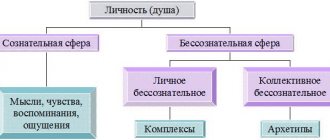“Social” is an adjective derived from the noun “socium” - “society”. In the modern Russian language there are many terms that are somehow related to the word “social”: social status, social responsibility, social security, social psychology... The list goes on. Most of its elements are firmly integrated into the everyday life of modern people, but it is impossible to understand what they mean if you do not know the meaning of the concept “social” itself.
Concept
A person cannot exist outside of society .
This is its main difference from animals.
A social personality is any individual who belongs to social groups, enters into social relations, and is an independent member of society with certain rights and responsibilities.
Each person has many social personalities, since his life in society, as a rule, is quite multifaceted . The same person can be perceived differently from a social point of view by different people in his environment.
For example, the social personality seen by colleagues may have nothing in common with the personality familiar to friends or relatives.
The socio-psychological side of any personality includes a complex of specific individual parameters. Each personality is a separate person, with an inherent set of social and psychological traits.
The formation of a socio-psychological portrait of an individual is influenced by many factors: anatomical features, mental properties, immediate environment, social groups, education, sphere of professional activity, ideology, religion, etc.
Each person is initially a “blank slate” , which, in the process of socialization, under the influence of the above factors, begins to form into a specific personality with its own individual set of psychological and social traits.
Alternative meaning
Social is not only related to public life. Sometimes this term characterizes something that radically changes this life, makes significant amendments to it, and sharp and radical ones.
A revolution or a revolution can be social. The meaning of the word “social” in this case is changing social life. The most striking examples of such changes are the English Revolution in the seventeenth century and the Great French Revolution in the eighteenth.
Types
In modern science, it is customary to distinguish the following social personality types from the point of view of value orientations inherent in individuals:
- Traditionalists . For them, law-abidingness, diligence, discipline and responsibility come first. Similar traits are observed against the background of a lack of desire for self-realization and independence.
- Idealists . They are the exact opposite of traditionalists. They strive to prove themselves and act in accordance with their own attitudes and principles. They do not recognize authorities and traditional views on issues.
- Frustrated type . These people do not feel involved in public life or in making important public decisions. They are characterized by low self-esteem, a constant state of depression and passivity.
- Realists .
Such individuals competently combine the desire for self-realization with an awareness of a sense of duty. They are able to rationally approach problems and objectively assess the proposed circumstances. - Hedonistic materialists. They are typical consumers who strive for immediate pleasures without thinking about the future. Their own desires always come first for them.
Personality types:
Social in man
Man is the only representative of the animal world who does not adapt to the environment, but adapts it to himself. It is worth noting that human influence on nature can be both destructive and creative. With his actions, he can disrupt its natural harmony, or he can ennoble the world around him, turning gloomy swamps into blooming gardens.
Moreover, almost any human activity is inextricably linked with society. It is only in our interaction with other members of our species and with the environment that we become human, for only then are we truly different from other animals. Our social essence manifests itself through communication, conscious work, the ability to compromise and the desire to be creative by creating something for others.
Socio-psychological portrait
Each person has a bright individuality, consisting of natural, social, and psychological characteristics.
A socio-psychological portrait of any individual can be drawn up based on an analysis of the following components:
- temperament;
- character;
- skills and abilities;
- level of intelligence;
- emotionality;
- strong-willed qualities;
- communication skills;
- level of self-esteem;
- degree of self-control.
In the process of socialization of a person in society, these components constantly change and develop. This occurs as a result of assimilating social experience , obtaining new ideas about the surrounding reality, acquiring knowledge, mastering behavioral patterns, etc.
For this reason, the socio-psychological portrait of a person is formed throughout his life.
Main factors of human anthropogenesis
Anthropogenesis is the process of human development that is directly influenced by biological and social factors of development.
The biological properties of evolution affect all representatives of living nature, including humans. These include: variability of heredity, struggle for survival, mutations and genetic drift, natural selection.
Social factors include: culture, work, thinking, the formation of moral qualities, the development of social consciousness and speech.
The most important engine of evolution is labor activity
- the ability to create tools for work belongs purely to humans, while animals use auxiliary means for hunting and building housing.
If biological developmental characteristics are transmitted hereditarily, then the acquisition of social ones occurs only during education and upbringing.
Properties and qualities
Socio-psychological properties are stable, individual traits of a particular individual that allow him to be characterized from a social and psychological point of view.
These properties are divided into four groups:
- properties associated with the development and use of social abilities (intellectual level, imagination, networking, etc.);
- properties formed under the influence of the group and as a result of intragroup interaction (knowledge, skills, behavior patterns, etc.);
- properties associated with social behavior, the position of the individual (activity, responsibility, sense of duty, desire to cooperate, etc.);
- properties based on the psychological characteristics of the individual (openness of thinking, mental agility, model of response to critical situations, etc.).
Socio-psychological qualities are personality characteristics that are formed in the process of interaction with other people, during communication.
Depending on his qualities, a person can perform certain social roles and occupy a specific social position. The standard classification provides for the division of people into three types in accordance with their inherent qualities:
- Athletics . People with an active lifestyle who always strive to dominate and manage.
- Picnics . People with well-developed adaptive mechanisms that allow them to easily enter into communications and successfully avoid conflict situations.
- Asthenics . Classic introverts who prefer solitude.
What does an antisocial person mean?
In order to understand who an antisocial person is and not to confuse this concept with antisocial, misanthropic and others, it is necessary to analyze the psychological root causes of the characteristics of this type of character, which does not belong to pathological disorders, but to the sociopathic spectrum. Initially, this is associated with disorders of the emotional spectrum; for such people it is not only difficult to actively and violently demonstrate their emotions, but even to express them verbally; some states remain closed to description, and only psychotechnicians help to understand what is happening inside. Since others demonstrate their feelings more clearly and talk about them more often, the antisocial type becomes uncomfortable and incomprehensible in their company.
Values and importance are dominated by one's own views and priorities, so social rules and norms will be ignored. For example, if an antisocial person becomes bored, then he will not withstand a cultural pause, wait for goodbye, but will simply leave (performance, guests - it doesn’t matter). He will also not smile at someone in order to make a pleasant impression; a smile will appear only in a good mood, and polite communication only if there is respect for the interlocutor.
Due to reduced sensitivity in the emotional area, a common reaction to any intrusion or attempt to impose social norms is aggression. It is the only way to respond to any irritants, while in order to achieve what he wants from other people, an antisocial personality easily uses manipulation, lies, and puts on any role. It turns out that asocial human behavior does not exclude adaptation, but uses it only in those situations when it is necessary for him, otherwise a cruel confrontation simply turns on.
A high level of impulsiveness does not allow an antisocial person to find adequate ways to satisfy his desires, but the need to realize them becomes extremely acute and requires fulfillment the second they arise. This leads to the fact that people carry out not very good actions just to get what they want faster, and it is difficult to explain to them the unworthiness of such a choice, since they are not able to understand the feelings of others and their suffering or pain, there is no shame and guilt, as the main regulators of social behavior.
Asocial people are also in no hurry to correct unworthy actions, because even when they see the tears, pain and grief of others, they are completely confident that they are right, and the undesirable behavior of others is considered as manipulation and attempts to exert pressure. They do not analyze their negative actions and do not use them as experience, i.e. once they apologize to someone, they can continue to do the same things.
Many patterns of behavior can emerge from such personality traits, so it is impossible to describe sociopathicity or asociality as a manifestation of one thing in a limited set. There will be no instructions with quotes, but only an understanding of a person’s internal motivation and his social isolation. Even towards their partners, who may be the center of the universe and truly loved, an antisocial person will not show feelings, especially sensitivity. This is difficult to believe for those who are not in close contact with them, because in superficial relationships, antisocial individuals are very charismatic and attract the interest of almost everyone.
Peculiarities
From a socio-psychological point of view, the personality has the following characteristic features:
- is not only an object, but also a subject of social relations, since it has freedom of choice;
- is unique because it has an individual set of social and psychological characteristics;
- formed under the influence of society (socialization process);
- understands his attitude to various events, phenomena, social attitudes;
- understands his needs, desires and goals;
- strives for self-realization;
- independently forms an opinion about members of society with whom he enters into various communications;
- fully involved in relations with the surrounding reality;
- engages in specific activities that allow one to satisfy material needs and occupy a certain place in society.
Rating of cities with low social responsibility
The marketing agency Zoom Market conducted a study in Russia, the purpose of which was to find out in which cities live more men who use the services of representatives of the “most ancient profession”.
The result is the following list:
1. Ekaterinburg 2. Krasnodar 3. Moscow 4. Novosibirsk 5. Samara 6. Vladivostok 7. Rostov-on-Don 8. Chelyabinsk 9. St. Petersburg 10. Voronezh 11. Ufa 12. Krasnoyarsk 13. Sochi 14. Omsk 15. Perm 16. Tambov 17. Kazan 18. Nizhny Novgorod 19. Chita 20. Simferopol 21. Bryansk 22. Saratov 23. Volgograd 24. Saransk 25. Ivanovo
Analysis Options
The socio-psychological parameters of personality analysis are as follows:
- Maturity . The highest level of maturity is the presence of certain life attitudes and views. A mature person is guided in his actions by an individual value system. He occupies a respected position in society and is an object to be emulated; he does not give up his views even under the threat of violence. Such a person can contribute to the development of other members of society who take their example from him. An immature personality is characterized by the absence of a clear value system and a low level of social responsibility.
- Adaptation .
This is the degree of adaptation of a person to the life of society. With conflict adaptation, non-acceptance of social norms occurs, which leads to psychological tension and difficulties with self-realization. With average adaptation, a person fully gets used to the surrounding reality and functions more or less successfully in society. With a high level of adaptation, the individual not only adapts to the surrounding reality, but also successfully develops in the proposed conditions. - Adequacy . This is the acceptance and assimilation by a person of the norms and principles existing in society. An individual does not simply externally adjust his behavior to generally accepted models, but internally transforms himself in the process of socialization. People who are adequate from a social point of view are distinguished by a high level of morality and ethics.
- Identity . This is the result of a person's self-identification. Having realized his “I”, an individual can compare the demands put forward by society and the opportunities provided with his abilities and desires. As a result, a mechanism for regulating behavior in society is developed, taking into account ideas about oneself.
Possible reasons
Growing up in a dysfunctional family can lead to the development of antisocial behavior
Antisocial behavior does not arise out of nowhere; it is a consequence of the influence of certain factors that may have pedagogical, medical or social roots.
Medical reasons include:
- presence of psychosomatic abnormalities;
- infantilism;
- ADHD;
- infection of a child during intrauterine development;
- schizotypal disorder;
- schizophrenia;
- brain injury or infection.
Pedagogical reasons include:
- excessive demands on the child;
- reliability in satisfying all the baby’s whims;
- having a negative role model (parents or other family members);
- frequent, and most importantly, unfair punishments;
- complete disregard for the baby's needs;
- the presence of hypo- or hyperprotection;
- lack of trust in the family.
Social reasons include:
- the desire to assert oneself at the expense of another person;
- social or material inequality;
- influence of subcultures, religious sects;
- growing up in a dysfunctional family;
- experience of sexual or physical violence;
- bullying, harassment, ridicule;
- problems in communicating with peers in adolescents and children;
- the presence of addictions that provoke the development of deviant behavior.
Maturity
Social maturity is the ability of a person living in society to take responsibility and make decisions.
A mature person is characterized by integrity of character, predictability, and positive behavior.
A mature person is always clearly aware of his goals and strives to achieve them, without violating the interests of other members of society. Such people evaluate themselves and the people around them extremely objectively and make decisions in accordance with the circumstances.
Achieving social maturity does not eliminate the need for other people . A mature person continues to learn new experiences, reconsider his views and work on himself throughout his life. But other people for him are advisers and interlocutors, and not teachers and mentors.
Precautionary measures
Prevention of the development of asociality in children and adolescents includes the following tips:
- take care of the baby’s emotional state;
- become a positive example for your child, promote a healthy lifestyle and correct values;
- create intra-family trusting relationships;
- If necessary, attend psychological consultations in a timely manner.
Now you know what people with antisocial behavior are like. This does not mean that it is necessary to isolate yourself from communication with such individuals. It would be much more correct to put an antisocial person on the right path, to help him socialize, if this is in your power.
The relationship between biological and social
Man is a biological organism that appeared as a result of evolution. Various natural processes occur in the body of each person, which to some extent determine his behavior.
But it is impossible to evaluate a person from a biological point of view alone, since he is at the same time a social being.
As a product of society , a person undergoes a process of socialization, as a result of which certain norms, principles of behavior, rules, views, etc. are adopted.
Moreover, during socialization, the individual traits of a particular individual have a great influence on the assimilation of all these principles, since he passes all the information transmitted by society through the prism of his own consciousness .
Thus, information stored at the genetic level distinguishes a person from other living organisms and forms his biological nature. And the education and upbringing received in the process of socialization forms the social component .
Biological in man
From the point of view of anatomy and physiology, man is the most common biological creature. Each of the systems present in our body solves certain biological problems. For example, the circulatory system provides all organs with oxygen and nutrients, and the lymphatic system ensures their cleansing.
We are completely dependent on the state of these systems, so we must constantly maintain them. We need to sleep, eat, and satisfy other physiological needs. Nevertheless, sometimes we get sick, and then the whole body begins to “fail.” But soon the immune system copes with the disease, and all systems work as usual again. All these processes are purely biological , and occur in us in exactly the same way as in most warm-blooded animals.
Interestingly, many of our systems are inferior in their capabilities to similar animal systems. Our eyesight cannot compare to that of an eagle, we cannot run as fast as a cheetah, and our stomachs cannot digest grass into nutrients the way a cow's stomach can. Nevertheless, in our overall potential we are superior to all animals, and this is ensured precisely by our social nature.
E. Erikson's theory of psychosocial development
E. Erikson argued that a person develops throughout his life.
From birth to death, it goes through 8 stages, each of which is accompanied by a certain crisis :
- infancy (0-1 year);
- early childhood (1-3 years);
- childhood (3-6 years);
- school age (6-12 years);
- adolescence and youth (12-20 years);
- early maturity (20-25 years);
- middle age (25-65 years);
- late maturity (after 65 years).
Every crisis can end well or negatively .
If a person successfully overcomes it, then he moves on to the next stage of life with good prerequisites for further personal development.
If the crisis is not overcome, then the transition to the next level still occurs, but unresolved problems at the new level remain with the person.
How to communicate with antisocial people
- If there are such individuals in your circle of friends, then, if possible, reduce communication with them to a minimum.
- If an antisocial individual is capable of showing aggression, do not enter into an argument with him, it will cost you more.
- Try to set an example for others to follow with your behavior.
- If you want to help such a person, if possible, find out what exactly led to the development of asociality. And, if you have any influence on this individual, advise him to seek help from a psychologist.
Teachings of Erich Fromm
Erich Fromm, a German sociologist and philosopher, argued that the type of human activity is determined by his considerations and living conditions, considerations, in turn, are determined by the structure of the personality. According to his teaching, several types of social character can be distinguished.
Receptive (passive or masochistic)
Beliefs: the source of all benefits is external, it is impossible to create anything on your own, the only way to achieve what you want is to resort to outside help.
Characteristics: they try to resort to the help of others, are extremely irresponsible, in case of failures they shift the blame onto someone else, are highly dependent on authority figures in their social circle, and never occupy leading positions.
Social relationships: they want to be loved, but do not want to love themselves, are not proactive, dependent.
Exploitative (sadistic)
Beliefs: the source of all benefits is in the external environment, it is impossible to achieve what you want on your own, you cannot create something yourself, but you can steal and recycle someone else’s.
Characteristics: they achieve what they want through manipulation and cunning, impose their life beliefs on others, do not tolerate dissent, are easy to work with and are very productive in their field of activity.
Social relationships: interested only in those who need to be conquered or “recaptured”, strive to take a leading position, extremely sociable, but often hostile; They evaluate others according to their degree of usefulness, they are cynics, they treat new acquaintances with suspicion, they are envious of the successes of others and are very jealous.
Hoarding (acquisitive, destructive)
Beliefs: it is impossible to create - you need to protect and save what you already have, they strive to get as much as possible and give as little as possible.
Characteristics: their home is their main fortress, which they strive to make as comfortable as possible by placing a huge number of things there, they try to restore order everywhere, they do not like change.
Social relationships: they are always under someone’s control, rarely take initiative, are silent and think a lot, structuring and analyzing thoughts, they are stingy with emotions and do not like conflicts.
Market (conformist)
Beliefs: success depends on the ability to present oneself correctly; everyone, including themselves, is a commodity with which they must compete.
Characteristics: they follow the “demand” and quickly adapt to the latest trends, losing their individuality in the process, often adopting the images that are broadcast by the media, and often sacrifice their self-esteem.
Social relationships: they ask the price of others, strive to make useful acquaintances, do not tolerate criticism and other threats to self-esteem, are often unsure of themselves, rarely experience real feelings - they neither love nor hate, do not become attached to anyone and do not value anyone, easily break up communications.
Perceiver
Beliefs: It is impossible to create on your own, but it is possible to help others create.
Characteristics: dependent on others, lack individuality, often live someone else’s life.
Social relationships: sociable, sincerely happy about the successes of others, talk a lot and laugh loudly, always have a large social circle.
Necrophiliac
Beliefs: they don’t think about creation, life is a tragedy.
Characteristics: extremely destructive, prone to depression, have a flexible psyche, and are often religious fanatics or ardent adherents of radical movements.
Social relationships: dependent on other people, suggestible.
Social (sociophilic)
Beliefs: development is the main task of life; they can either create it independently or help others in this.
Characteristics: mature, harmonious individuals, attentive to details, strive to study the world around them, do not oppose themselves to society, but also do not strive to meet its requirements, are aware of their strengths.
Social relationships: they love people, are patient, strive to surround loved ones with care, in the process of their development they try to involve others in the development.
Examples from life
Concluding the conversation about social status and social role, let's consider several situations related to a change in position in society.
Workers and peasants of the USSR
As a result of the October Revolution in Russia, the status of workers and peasants as an exploited class was replaced by the status of a ruling class.
Workers and peasants became the masters of the young state, and tsarism and the bourgeoisie lost their position as a privileged stratum and were expelled from the country or physically destroyed. But after a few decades, a new class was formed: the military, political and intellectual elite, then the creative intelligentsia and show business. They possessed financial and intellectual power, connections and other attributes of high status, unlike workers and peasants, and displaced them from the top of the social pyramid.
Megxit
Having become the wife of Prince Harry, Meghan Markle received the status of a member of the royal family and the title of Duchess of Sussex.
But after the birth of the heir, the Duke and Duchess officially refused to give him the title of prince. And a year later, they themselves renounced their titles (and, accordingly, the status of members of the royal family and pretenders to the throne), decided to leave England and work in the USA, maintaining their acquired status as professionals, parents and public figures.
GreenPeace
Animal protection and environmental movements have never been a priority, since in general humanity has not yet fully recognized the importance of the “green” movement.
Over time, the association of thousands of volunteers, due to their numbers and public resonance, gained the ability to influence producers of goods and services, consumer interest, legislative bodies and even political decisions of authorities in many countries of the world.
But it would still be wrong to consider this association prestigious, since most of its participants do not receive direct material benefits.
[media=
https://youtu.be/dcz97eGGLWI
]








